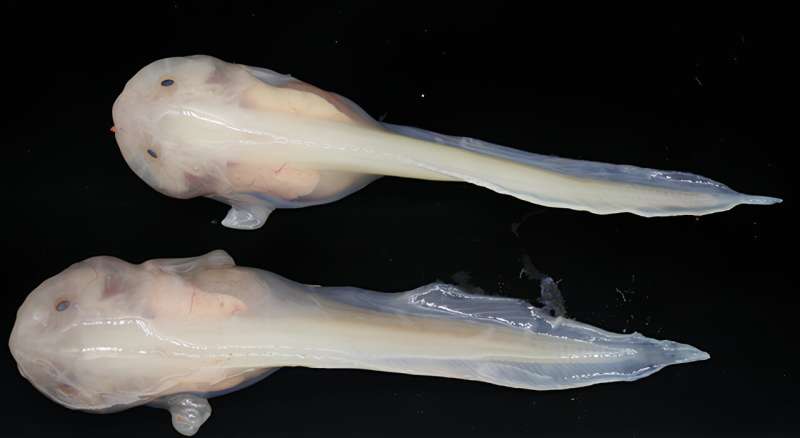This article has been reviewed according to Science X's editorial process and policies. Editors have highlighted the following attributes while ensuring the content's credibility:
fact-checked
peer-reviewed publication
trusted source
proofread
Scientists reveal how deepest sea dwellers adapted to their environment

A genetic analysis of the hadal snailfish, the deepest-dwelling known vertebrate species, has suggested a number of key adaptations that allow it to survive more than 6,000 meters under the sea.
The findings, published today as an eLife Reviewed Preprint, provides what the editors describe as convincing evidence for the mechanisms of deep-sea adaptation and the evolutionary history of the hadal snailfish.
The results suggest that possessing multiple copies of two genes, cldnj and fthl27, allows the hadal snailfish to maintain their auditory senses and withstand the immense pressure to which they are subjected underwater.
The hadal snailfish has captivated biologists as the deepest underwater vertebrate on record. The hadal zone, after which it is named, is characterized by high hydrostatic pressure from the depth and density of the ocean water, complete darkness, and barrenness. Long-term studies of the species are difficult to conduct, due to the difficulty of observing organisms at such depths.
"There are a number of gaps in our knowledge of the hadal snailfish," says lead author Wenjie Xu at the School of Ecology and Environment, Northwestern Polytechnical University, Xi'an, China. "Questions remain about how it entered and adapted to the hadal zone—what sense does it rely on, and how does it tolerate the extreme hydrostatic pressures it is subject to?"
To address these questions, Xu and colleagues collected four hadal snailfish (Pseudoliparis swirei) from the Mariana Trench of the Pacific Ocean, and four shallow-dwelling Tanaka's snailfish from the Yellow Sea. Using a combination of DNA sequencing technologies, the team was able to generate an assembly of all of the genes present in each species. By comparing and contrasting the rates of expression of genes between the deep-dwelling and shallow-dwelling species, the team could infer when the hadal snailfish first entered the hadal zone, and the genetic variations that allowed it to adapt and reproduce in the new environment.
Using this data, the team estimated that the hadal snailfish and Tanaka's snailfish diverged from each other about 18 million years ago, and further estimated that the hadal snailfish and other Liparidae species living at around 1,000 meters diverged about 9.9 million years ago—close to the time of the Mariana Trench's formation. Therefore, they speculate that the ancestor of the hadal snailfish first adapted to deep seas of 1,000 meters around 9.9 million years ago, and gradually adapted to greater depths as the Mariana Trench formed.
The complete absence of light in the hadal zone appears to have had a profound effect on the hadal snailfish, the scientists say. They observed a substantial loss of many genes related to vision, suggesting that the ability to see was no longer important for survival due to the lack of light in the hadal zone. In addition, many genes related to circadian rhythms were absent, although some essential clock control genes were still present. This suggests that the hadal snailfish's rhythmic cycle has been maintained, but is no longer based on the movement of the sun. The loss of the gene gpr27, which increases lipid mobilization, could also be a key mechanism by which the hadal snailfish survives periods of starvation.
It has previously been suggested that the compound TMAO, which is able to maintain protein function under high pressure, was the key factor in allowing hadal snailfish to survive at greater depths than any other known vertebrate. However, the team observed that the expression of the TMAO-generating enzyme flavin monooxygenase 3 (fmo3) in the hadal snailfish were the same as those in many surface-dwelling marine species. Instead, Xu and colleagues propose that multiple copies and increased expression of two genes in hadal snailfish may play a more critical role than TMAO.
The first is cldnj, a gene essential for the formation of otoliths—a structure in the inner ear made of calcium carbonate. Typically, calcium carbonate cannot efficiently accumulate to form otoliths beyond around 4,000 meters underwater. However, the otoliths of the hadal snailfish were just as dense as those of Tanaka's snailfish. It is therefore likely that the three copies of cldnj possessed by hadal snailfish are essential for maintaining otolith integrity in the hadal zone and maintaining auditory function.
The second gene is fthl27, which encodes the protein ferritin. This protein significantly increases tolerance to reactive oxygen species that are responsible for the damage caused by high hydrostatic pressure. Hadal snailfish have 14 copies of fthl27, compared to three copies in Tanaka's snailfish. It is likely that this massive expansion and high expression of fthl27, along with many genes related to DNA repair in hadal snailfish, was critical in allowing them to adapt to the hadal zone's environment.
The authors call for further research into the adaptations of the hadal snailfish to consolidate their findings. Particularly, they say the adaptation of its nervous system to withstand high hydrostatic pressure warrants a more in-depth study in the future.
"Our study provides a chromosome-level genomic analysis of the hadal snailfish, furthering our understanding of the origins and adaptive mechanisms of this species," concludes co-senior author Shunping He, a Professor in the Institute of Deep-Sea Science and Engineering, Chinese Academy of Sciences, Sanya, China. He served as co-senior author of the study, alongside Kun Wang, a researcher in the School of Ecology and Environment, Northwestern Polytechnical University. "We propose that the hadal snailfish only entered the hadal zone relatively recently, in the last few million years, after the full completion of the Mariana Trench, and have subsequently spread to different ocean trenches within 1 million years."
More information: Wen-Jie Xu et al, Chromosome-level genome assembly of hadal snailfish reveals mechanisms of deep-sea adaptation in vertebrates, (2023). DOI: 10.7554/eLife.87198.1
Journal information: eLife
Provided by eLife
















